|
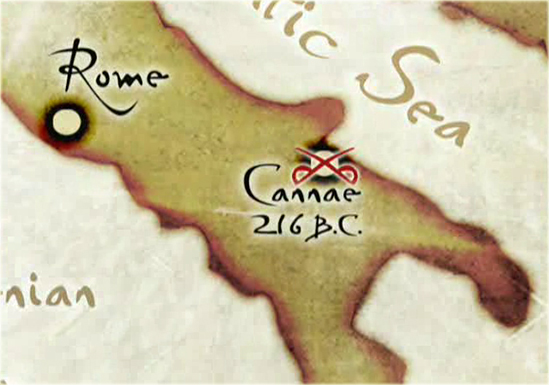
Cannae 216 BC - Map Location and
Proximity to Rome
History Channel
Battle of Cannae —
August 2, 216 BC
The
Battle of Cannae was part of the
 Second Punic
War.
Second Punic
War.
|
|
Cannae was an ancient town in
southern Italy (see map location
above.) The flat plain of Cannae was
perfect for cavalry warfare.
And here
is the ancient battlefield of Cannae today:
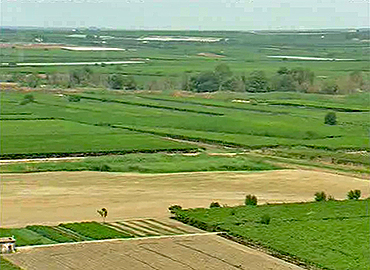
Cannae Battlefield Today
History Channel
Almost
130,000 men and 16,000 horses were
squeezed into this battle field just
two miles square.
Who Fought the Battle of Cannae?
Carthage and Rome fought each other
in a battle for supremacy in the
Mediterranean.
 Hannibal led the Carthaginians
and their allies - Africans (Numidians),
Gauls, and Spaniards.
Hannibal led the Carthaginians
and their allies - Africans (Numidians),
Gauls, and Spaniards.
|
The Romans were led by two commanders:
Paullus (Lucius Aemilius Paulus) and
Varro
(Gaius Terentius Varro.) Paulus'
commanded with a cautious strategy. Varro's strategy was more aggressive. These two men took turns leading the
army on alternate days. On August 2,
216 BC, it was Varro's turn to
command.
All in
all, the
fighting of the Battle of Cannae took
only 4 hours.
Who Won the Battle of Cannae? Who
Lost?
Hannibal and the Carthaginians won.
Rome suffered its worst defeat ever.
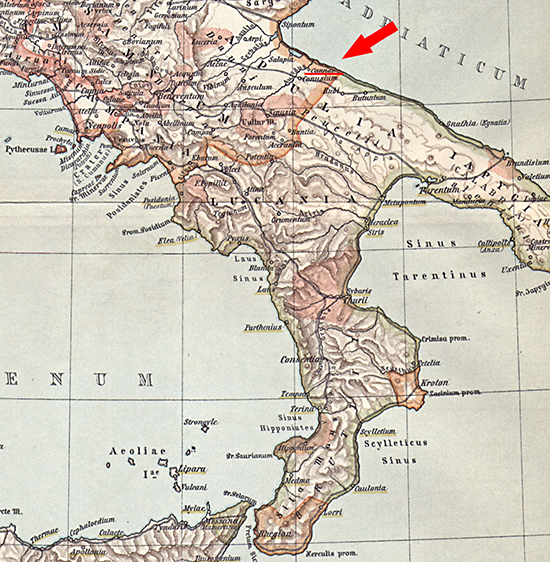
Cannae 216 BC - Map Location
Apulia (Puglia), Southeastern Italy
Meyers Großes Konversations-Lexikon
Click map to enlarge (huge map)
Why Was the Battle of Cannae Fought?
After
crushing the Romans at the
Battle of the
Trebia in 218 BC, Hannibal
repeated his victorious performance
in 217 BC at the
Battle of Trasimene.
While
continuing rolling down through
Italy, Hannibal and the
Carthaginians rested on the Adriatic
Sea, less than 100 miles from Rome.
In
desperation, the Romans decided to
gamble everything on one great
battle.
Check
here for Hannibal's invasion route:
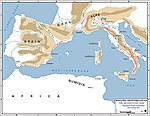
218 BC Hannibal's
Invasion Route
Click
map to enlarge
For more background information
to this battle check the
 Second Punic
War.
Second Punic
War.
The Contestants in Comparison
The
Romans were going for broke and
presented Hannibal with a massive
army, twice as big as anything that
had faced him before.
Cavalry: Hannibal had 10,000
horsemen. The
Romans had 6,000. Hannibal's
advantage.
Infantry: Hannibal had 40,000 men. The
Romans had 70,000. Rome's
advantage.
The Battle of Cannae Commences
The
Romans lined up with an unusually
deep and therefore narrow formation.
In his
book The Roman Army at War, Adrian
Goldsworthy states that,
At
Cannae, the unusually ill-trained
and inexperienced Roman legions were
deployed far deeper than was
normally the case.
What was going on?
Victor
Davis Hanson, California State
University, Fresno, further
enlightens us,
Either through wisdom or utter
folly, the [Roman] consuls had agreed to
stack the legions to create depth.
They had given up flexibility in
exchange for power.
What
was the Carthaginians' formation?
Outnumbered but not outwitted, Hannibal devised a trap.
He had his troops
line up in a crescent formation. He seemed to be inviting an
all out attack on his outnumbered
force. Together with his Gallic and
Spanish infantry, Hannibal positioned himself at the most
vulnerable part of the line, at the
center where the fighting would be
the fiercest.
Strangely, Hannibal left his
best troops, the Numidian spearmen in
reserve on the flanks of his army.
He positioned his cavalry on the
wings.
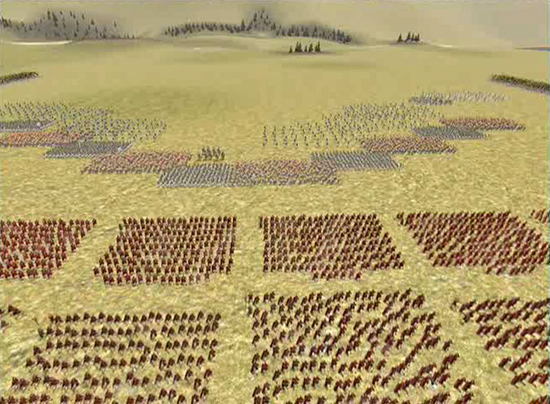
Battle Formation Cannae 216 BC
History Channel
The battle commenced. Skirmishers ran forward.
Legions advanced. The men of
Carthage, outnumbered two to one,
braced for impact.
Hannibal sent his heavy cavalry
straight for the Roman horsemen
under Paullus. Fighting was fierce
and brutal.
Meanwhile, Hannibal's Numidian cavalry charged the Roman left wing
under Varro.
While
the cavalry fought, the 8 legions of
Roman infantry rolled forward
towards Hannibal's position. When
they got within 15 yards, each
legionary threw his spear.
Then
they advanced drawing their swords
and collideded with the
Carthaginian crescent. Hannibal
suffered dreadful losses as the
legions hacked their way deeper.
Defeat seemed inevitable. Hannibal's
center was forced back, but it did
not break.
For
the Romans it seemed that one more
push would bring the victory. When
they realized that Hannibal's
crescent had become a circle, it was
too late. What had happened?
The Roman advance
had been sucked into
the center of the crescent, the
Numidian spearmen from the flanks
had turned around from both sides to
envelop the Romans.
Hannibal's cavalry
had defeated the Roman horsemen
on both flanks and moved around behind the
enemy.
The vast
Roman army was completely
encircled.
The
large body of Romans couldn't move
and thus couldn't use their weapons
properly. Neither could they
retreat. Had
they kept their wits they could have
made a breakout. But panic set in
and they were massacred en masse.
Only 14,000 Romans escaped.
Paullus was killed. Varro and five
hundred cavalry fled to Venusia,
today's Venosa, ten miles from
Cannae (see map above.)
Here
are the battle maps:

216 BC Battle of
Cannae - Phase One, Two, and Three
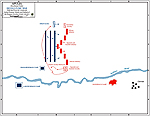
Map of the Battle of Cannae 216 BC - Initial Attack
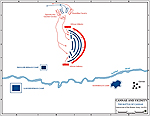
Map of the Battle of Cannae 216 BC - Final Attack
What Was So Special About the Battle
of Cannae?
The
Battle of Cannae was the bloodiest battle the ancient world
had ever seen.
With
regards to military strategy,
Hannibal pulled a classic double
envelopment.
Victor
Davis Hanson, California State
University, Fresno:
"What
happened at Cannae should not have
happened. Military strategists could
not envision that a numerically
inferior army could surround ... a
numerically superior force. The
very idea that someone like Hannibal
could pull that off was just
audacious."
What Were the Casualties of the
Battle of Cannae?
Over
100,000 men fought. Over half of
them died.
Between 44,000 and 50,000 Romans and 6,000 to 10,000
Carthaginians were slaughtered.
That's roughly 200 men each passing
minute.
Only
14,000 Romans could escape and
10,000 Romans were captured.
On top
of it, the Romans lost important
men:
The consul Aemilius Paulus was
killed, 20 other consuls and
praetorians were killed, 30 senators
were either captured or killed, 300
nobles were killed, and 40,000
infantrymen and 3,500 cavalrymen
lost their lives.
After the Battle
of Cannae
News
of the defeat terrified Rome. The
remaining senators packed their bags
and were ready to take flight. The
city was now at Hannibal's mercy.
But he refused to march on it, maybe because of exhaustion. He had just
fought the greatest battle of his
life and lost many of
his men. It is disputed whether an
immediate attack on Rome would have
given Hannibal the city. Some say,
it would have been a big
gamble. Others say, that there is no
doubt that it would have been a
victory for Hannibal and his men.
Be that as it may, instead of
attacking Rome, Hannibal lead his army for the
next fourteen years around Italy.
The moment had passed. He was too weak to conquer Rome,
and too strong
to be defeated in battle. He had dealt
Rome three massive blows but Rome
was still standing.
Moreover, Rome bounced back and a
re-vitalized Roman army attacked
Carthage. Hannibal was summoned back
to organize the defense but was
defeated at the
Battle of Zama, in North Africa.
The ancient historian
Florus
says that it was as if the Romans
rose from the dead after the Battle
of Cannae.
Rome won the war and went on to rule
the world.
The Battle of Cannae — Sources
And
these pictures show what's left
today of the ancient village of
Cannae:
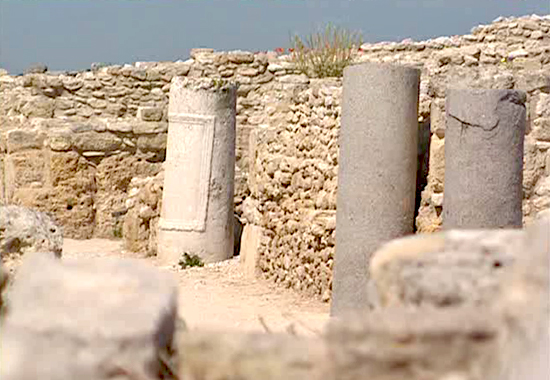
Ancient Village of Cannae Today
History Channel
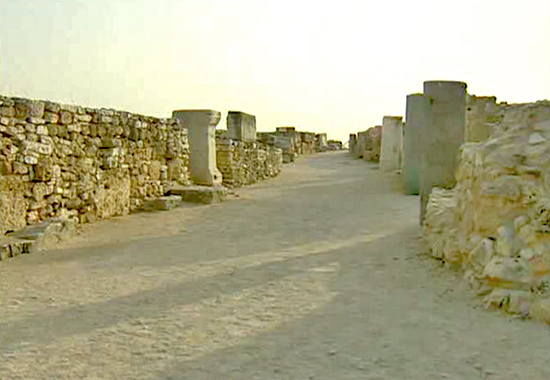
Ancient Village of Cannae Today
History Channel
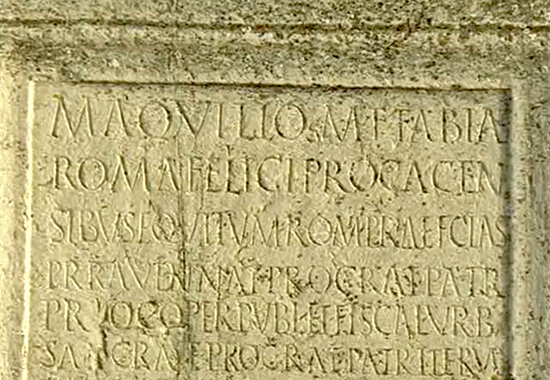
Ancient Village of Cannae Today
History Channel
More History
|